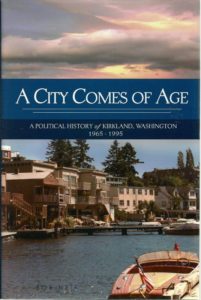

From the author, “Founder Peter Kirk’s dream of a city on the east shores of Lake Washington has been fulfilled, although not exactly as he imagined it. I have presented the events that helped shape Kirkland and introduced the citizens who worked to make Kirkland what it is today: a vibrant and thriving City.”
Bob has a distinguished career in public service having served in government for 22 years. Among his distinctions are: three terms as mayor of Kirkland; Chairman of the Metro Transit committee, member of the Port of Seattle Airport Commission, and founder of the Lake Washington School Foundation.
He and his wife, Christine have been residents of Kirkland since 1955. Their four sons are all graduates of Lake Washington High School.
Bob has generously donated 1,000 copies to the Kirkland Heritage Society as a fundraiser to support our continuing work on preserving Kirkland’s History.
From an urban Seattle Madrona neighborhood to wooded Rose Hill populated by mountain beavers and tall firs underlain with salal and Oregon grape, Chris and I settled in at 13013 NE 88th Street in February 1955. The house was new with a yard on a quiet dead-end street. NE 85th Street, the main thoroughfare, was a two-lane road with ditches on either side. Son David was born that March followed by sons Tom, Paul and Jim over the ensuing 5 ½ years. The older boys attended Rose Hill Elementary where I became active in the PTA and took an interest in school district affairs. The school district consisted of mostly Kirkland area schools. Redmond High School was the easternmost High School, a district quite large area-wise, but sparsely populated. The Sammamish plateau was yet to be discovered. It was understandable the School Board’s attention focused primarily on Kirkland schools. Community life centered about children and schools. In 1960, a school board vacancy occurred. I was one of three finalists. But the position was given to Dr. Alan Leider.
A brand new elementary, Mark Twain, opened in 1963 and our boys were transferred to the new school. Unfortunately, to get there, they had to walk on 132nd Avenue NE, a busy road, that had no provision for pedestrians and was dangerous for children. I decided to do something and contacted King County about an unopened, woods covered right-of-way on 130th Avenue NE that led directly to the new school. Al Coffelt, then assistant county engineer, gave me approval to build a trail (something you couldn’t do now-a-days without a big brouhaha). Contacting neighbors with school age children, I collected $5 apiece, bargained with reticent, bordering landowners to give it a try, and hired a bulldozer. On bulldozer day, Chris tore white strips from a bed sheet and I proceeded to mark a trail through the woods. The bulldozer operator, with his eight-foot blade, followed behind blazing a trail still in use today.
By the early 60s, we had outgrown our 3-bedroom, one bathroom rambler (even after having added a 14 by 28 foot family room addition in 1958). It was septic tank country (and still is today). King County wouldn’t permit a second bathroom, so we had to move. As it was, the kids were double-stacked in bunks in two small bedrooms sharing dressers. Pros Lamont, builder, and his partner Howard Rogers had built the house.
In 1960, we went looking for a lot. The federal government had just canceled Boeing’s DynaSoar and Supersonic Transport programs (I worked for Boeing). Times were grim. Waterfront property was selling for less than $100 a foot: we looked, but Chris shied away from waterfront property. As a child, her family had a summer home on Portage Lake in Michigan and she didn’t much care for water. View property had to be it. The kids and I hiked up a dirt path in Houghton and found a lot covered with fallen trees. We clambered out on a downed tree trunk: the view of Seattle and the Olympic mountains was spectacular. Below us were open fields, the old Collins school and the abandoned remains of Project “B” housing for the shipyard. I bought that lot from Ray Parks in 1960. Ray said I couldn’t build yet so I gave him money down and signed a note to pay the rest when the road and utilities were in. Ray called me in late 1963: we moved to Houghton in June 1964. I designed the house: Bob Fields drew up the plans and Pros Lamont built it. We were now Houghtonites.
The kids transferred to Lakeview Elementary. We tried to sell the house on Rose Hill, but there was no market so we kept it. Today, 2005, we still rent out that house. In 1968, I ran for the school board against incumbent Dr. Larry Dobbs. A great guy, but unopposed, which I didn’t think was right in a democracy. So, I ran and lost. Losing was one of the best things that ever happened to me. The School Board continued to call upon me to serve on a number of task forces, including the Citizens Advisory Committee in 1969. Show an interest in education and you get an assignment. I also came to appreciate a number of dedicated school leaders: Walt Ferguson, Ev Cox, Duane Thorsen, Alton Gregor, Russ McClintick, Ed Dorothy, Omar Peavey, Wayne Stenson, Gordon Hauck, just to name a few that come quickly to mind—many are still living in Kirkland in 2005. I guess true Kirklanders never leave.